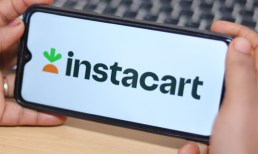With PYMNTS research finding that 34% of U.S. consumers are shopping for groceries online —76% for the convenience, 57% for the speed — it’s time for smart carts to start their ascent.
Grocery aggregator Instacart’s 2021 acquisition of smart cart first-mover Caper AI signaled a turning point in the future of checkout, and the innovation is just beginning there.
In a conversation with PYMNTS’ Karen Webster for the PYMNTS and PayPal collaboration series “Digital Payments Flip the Script: 10 Merchants and 10 Visions for Digital Transformation,” Caper CEO and Instacart Vice President Lindon Gao laid out an ambitious vision for how smart carts are transforming grocery.
Caper Cart is in use in chains including Kroger, Wakefern, Sobeys in Canada and an assortment of smaller retailers, and Gao told Webster that “so far reception has been really great.” He recalled how he watched a senior citizen use a Caper Cart quite easily, calling it an expression of “the ultimate goal we want to achieve. We want to build a product that everyone can use.”
With the Caper Cart designed to appeal to everyone from busy moms to Gen Zers and millennials who often prefer cashierless checkout experiences, Gao visualizes a highly scalable technology that blends the best of online shopping, digital payments and physical experience.
Grocers will like the fact that Caper Cart users have larger average basket sizes because the cart’s computer vision and artificial intelligence (AI) remember what shoppers forget, prompting them as they go down each aisle with reminders, recipes and other content.
Advertisement: Scroll to Continue
For example, someone who bought pasta might forget the sauce — unless prompted.
“By piecing these together, we could actually help customers complete their journey in a much faster way, such that they don’t end up in a checkout line realizing that they forgot something. Because of that, we have seen average basket size increases,” he said.
As Instacart integrates Caper into its “Instacart Platform” suite of solutions, storing payment card credentials is on the list, as are several other forthcoming enhancements.
Pressed on the matter of stored payment cards specifically, Gao said, “That’s on the roadmap of what we want to potentially build. There are also other features like shopping lists and how we integrate that with Caper.
“The vision for Instacart in this move to acquire Caper is really to create an omnichannel experience, and an omnichannel technology offering to retailers.”
He added, “The Instacart Platform is basically a suite of technologies that we can offer retailers to really partner with them and help them with every aspect of their in-store operations, to customer management and eCommerce.”
See also: Instacart Acquires Smart Cart Creator Caper AI to Power Omnichannel Tech for Grocery Store Customers
The eCommerce Engine for Grocery Revs Up
Instacart’s push to bring more grocers into the smart cart fold using its new platform is part of a larger retail enablement strategy the company is pursuing as it reinvents the grocery experience as an easy flow, where the platform knows you and the cart does the work.
That kind of innovation has serious potential, and Gao told Webster, “We could connect Instacart’s eCommerce enablement platform to Instacart’s in-store enablement platform and channel these together such that customers could place pickup orders online, and eventually staff could use a Caper Cart to fill these orders and deliver directly to customers.”
It ends up benefitting the consumer who places the order — convenience and speed — and the grocery store where customers move through faster and more efficiently. That sounds like an answer to the labor shortage, and it is, but perhaps not how we might think.
“By simplifying checkout for customers, now retailers have the capability to take their staff who is usually standing behind a cash register,” Gao said. “Now they can walk the floor and assist customers inside the store, enriching that experience. I think ultimately this is going to yield a much higher benefit for the retailers’ top line versus just realizing labor efficiency.”
Some of this comes from Caper’s experience with Kroger, which in 2021 piloted a smart cart program, essentially white-labeling Caper Cart as the KroGO and integrating with the chain’s loyalty program so shoppers could scan loyalty cards right from the cart at the start of their trip.
He said an essential lesson from the KroGO pilot “is that customer experience is really, really important” and if Caper Cart doesn’t provide it, consumers won’t use them. That set Gao’s engineers on a new path, especially regarding the payment portion of the journey.
Caper Cart has a built-in card reader, but Gao told Webster that embedded payments “is definitely on our roadmap. We’re not going to ask a customer to download an app just to process payments because that’s going to create additional friction.”
Rather, he said Caper is working on integrating with a user’s Instacart account “already tied to your credit card, so that you could just log in and you could leave. We could tie this to retailer’s loyalty programs and so forth, and thereby we could make it a lot more seamless.”
See also: Instacart Plans to Boost in-Store Presence With Smart Carts
More Caper In the Cards
As nicely as things appear to be progressing for Caper Cart, the company is struggling through the same disruptions as every other business, especially those that manufacture in Asia.
Gao said the company “saw a massive supply chain disruption in China. That has really caused a lot of the production delays for us. Right now, we’re really hindered more by supply rather than demand. We’re working our best to really pump through our production” and deliver more smart carts.
That’s a speed bump, and a big one, on the way to scaling the concept. However, while Caper is chipping away at its production issues, it’s also working on new checkout concepts.
For example, Caper Counter is a self-checkout solution for small footprint stores, stadiums and other venues where consumers have small orders and want to get out super-fast.
Noting that in these places “you don’t shop with a shopping cart,” Gao told Webster that in high traffic, high turnover retail environments, Caper Counter “helps benefit the throughputs, the efficiency and customer satisfaction. People absolutely love it.”
In time, the company will take Caper Counter to convenience stores, beauty stores and the like.
He said it aligns with an overall vision “that we’re not just a grocery eCommerce fulfillment company, but we’re also looking at the Petco’s, the drug stores of the world so that we could help customers essentially with everything that they need in the physical retail store.”
It also build out Instacart’s platform with what he called “five major pillars”: eCommerce, fulfillment, in-store advertisement, data and insights.
“With all this packaged together, we become extremely compelling for the retailers,” he said. “Instacart’s intention was never to compete with retailers. We want to be the retailer enablement platform.
“We believe that what’s best for retailers will be best for us. That’s why we built this Instacart platform to continue to push that technology and innovation for them.”



